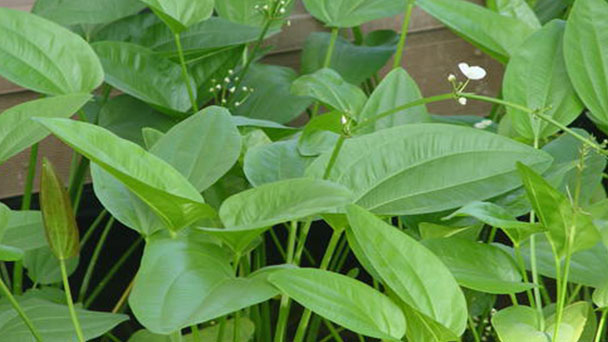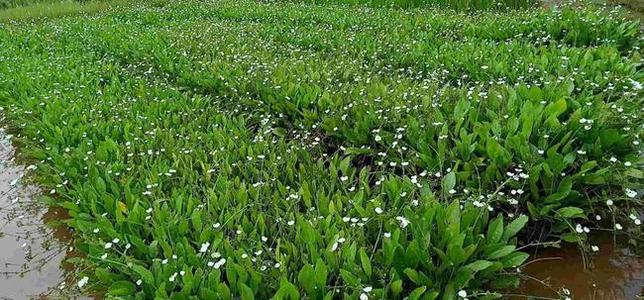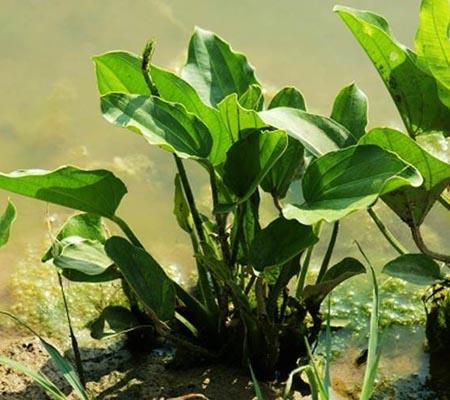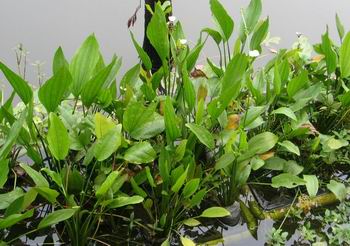Common water-plantain profile
Written by Maggie
Dec 22 2020

Alisma plantago-aquatica, also known as European water-plantain, common water-plantain or mad-dog weed, is a perennial flowering aquatic plant widespread across most of Europe and Asia from Portugal and Morocco to Japan, Kamchatka and Vietnam.
Common Water - Plantain picture

Common Water - Plantain morphological characteristics
Common water-plantain is a perennial aquatic or bog herb. Tubers are 1-3.5 cm in diameter, or larger.
Leaves: usually numerous; Submerged leaves are striate or lanceolate; Leaves are broadly lanceolate, elliptic to ovate, 2-11 cm long, 1.3-7 cm wide, apex acuminate, thinly acute, base broadly cuneate, shallow cordate, veins usually 5, petiole 1.5-30 cm long, base gradually, margin membranous.
Flower: Scapes 78-100 cm, or higher; Inflorescences are 15 -- 50 cm long, or longer, with 3 -- 8 round branches, 3 -- 9 per round. Flowers are bisexual, pedicel 1-3.5 cm long; Outer tepals are broadly ovate, 2.5-3.5 mm long, 2-3 mm wide, usually 7-veined, margin membranous, inner tepals suborbicular, much larger than outer tepals, margins irregularly coarsely dentate, white, pink or purplish; Common Water - Plantain has carpels, neatly arranged, style erect, 7 -- 15 mm long, longer than carpels, stigma short, about 1/9-1/5 of style; Filaments are 1.5-1.7 mm long, base ca. 0.5 mm wide, anthers ca. 1 mm long, elliptic, yellow, or pale green;Flower topiary convex, ca. 0.3 mm high, suborbicular.
Fruit: Achenes elliptic, or sub rectangular, ca. 2.5 mm long, ca. 1.5 mm wide, dorsal with 1-2 inconspicuous shallow furrows, lower flat, fruit beak from ventral protruding, beak base convex, membranous. Seeds are purplish-brown, protuberant. Flowering period is from May to October.
Common water-Plantain growing environment
Common water-plantain is found in shallow waters of lakes, inlets, streams and ponds. It is also found in marshes, ditches and low-lying wetlands.
Common Water-Plantain distribution range
Common Water-Plantain is produced in Heilongjiang, Jilin, Liaoning, Inner Mongolia, Hebei, Shanxi, Shaanxi, Xinjiang, Yunnan and other provinces. The former Soviet Union, Japan, Europe, North America, Oceania are distributed.
Common Water-Plantain cultivation technique
Propagation methods
Common water-plantain can propagate by seed, shoot or tuber. Generally, seeds should be cultivated before seedlings are transplanted. Seed cultivation is to dig out the selected seed plant, use bud splitting propagation or tuber propagation to cultivate separately, and harvest the mature seed. The growing period is about 180 days, including about 30 days for the seedling stage and about 150 days for the adult stage. Seed maturity is different, emergence has successively.
After soaking and sowing, Common Water-Plantain seeds can germinate in one day at 30℃. When the temperature is above 28℃, it only takes 5-7 days for the seeds to germinate until the first true leaf grows. Overground plants and underground tubers grow rapidly in autumn and very slowly in winter.

Choose to soil preparation
Seedlings should choose sufficient sunlight, deep soil layer, fertile slightly viscous, drainage and irrigation convenient fields, seedlings a few days before sowing dry water. After ploughing, 3,000 kg of compost will be applied to each acre of land, and then the soil will be raked evenly to form a width of 1-1.2 meters for sowing.
Semination
Before sowing, soak the Common Water-Plantain seeds in water for 24-48 hours, dry the moisture, and mix them with grass and wood ash. Broadcast period, Sichuan in mid-June to early July, Fujian in early July, Jiangxi in late July, sowing, about 5 days, most germination. Generally, 1hm2 of seedlings can be raised, and about 25hm2 can be planted.
The transplanting period is usually in August. Autumn seedlings (17-20cm) are selected according to the row spacing (30-33) cm * (24-27) cm, one seedling is planted in each hole, and the seedlings are put into the mud (3-4cm).
Common Water-Plantain should be transplanted from mid-October to early November. When seedlings are 15 cm tall and have 6-8 true leaves, they can be transplanted.10,000-11,000 seedlings per acre. When transplanting, it should be done after 3 o 'clock in the afternoon on cloudy or sunny days. Sturdy seedlings of about 15 cm in height should be selected and planted at random. The row spacing of Common Water-Plantain should be 25-30 cm, and 7000-9000 seedlings should be planted in 1/15 hectare. Seedlings should be planted straight, stable, shallow, generally in the root and can be planted into the soil. Seedlings should be shallowly planted into the mud 2-3 cm deep, straight, stable, after transplanting the field to maintain shallow irrigation.
Field management
Supporting seedlings and supplementing seedlings: After transplanting, check the next day to find the fallen seedlings, and it should be upright; Lack of seedlings should be made up to ensure that all seedlings.
Weeding and topdressing: Common Water-Plantain usually yun to fields, weeding and topdressing three to four times during its growth. All three continue at the same time.
Irrigation and drainage: Common Water-Plantain irrigation is advisable during the growth period. After transplanting, the water depth was maintained to 2-3 cm. After weeding the field the second time, the water depth was usually maintained to 3-7 cm. After mid-November, the water was gradually drained out to bake the field for harvesting.
Scape and side buds: In late September, after weeding the field for the second time, Common Water-Plantain extracted flower stems and side buds one after another, which consumed nutrients and affected the yield and quality of flowers. Therefore, except for those who kept seeds, the stems and side buds should be removed in time.
Harvesting and processing
Seed:
(1) Plant separation and seed retention: before harvesting, select Common Water-Plantain with robust growth, no pests and diseases, and hypertrophy of tubers in large fields as seed plants. When harvesting, dig up the withered stems and leaves from the ground, and transplant the tubers into a wet field, and plant Common Water-Plantain sideways into the soil, 7-10 cm deep, not too deep or too shallow, too deep tubers are easy to rot, too shallow susceptible to freezing damage. After planting, cover straw and weeds with insulation and antifreeze. After the start of spring of the following year, each tuber can sprout more than 10 new buds. When the new buds grow into seedlings of about 20cm, dig the tubers, cut them into individual plants according to the new seedlings, and transplant them into paddy fields with sufficient sunshine and fertile soil. The spacing between the rows is 30-40cm. After planting, strengthen management, fruit ripening in July and August. When the fruit is yellowish brown, the stem is cut in batches. Then the fruit sticks into a small, ventilated dry place after the shade dry, threshing.Sow the next year.
(2) Tuber retention seed: before harvesting, select the plant according to the above method, and then dig, remove the stems and leaves, and tuber planted in a fertile paddy field. After germination in spring of the following year, lateral buds were removed and only main buds were left for flowering and fruiting. Fruit ripens in late June. After picking, the fruit should be ventilated in the dry place, ripening, dry in the shade and threshing. Common Water-Plantain can be planted in the same year as seedling cultivation. The seed produced by tuber retention had strong vitality and high germination rate, but the yield was not as high as that of tuber retention.
Harvest: Common Water-Plantain was transplanted in late December of the same year, and could be harvested when the stems and leaves on the ground were withered and yellow.
Processing: after the tubers are transported back, remove the fibrous roots, and immediately expose to the sun or bake dry, and then put into the cage to knock out the residual fibrous roots and thick skin, so that the tubers smooth, yellowish white can be. Generally, it can produce 150-200 kg dry goods per 1/15 ha, and 250-350 kg for high yield in Southern Fujian. During storage, moth - proofing should be used. To a large, smooth, yellow and white, pink foot is preferred.

Common Water-Plantain pest control
White spot: Harmful to the Common Water-Plantain leaves. The leaves can be soaked in 80 times of 40% formaldehyde for 5min before sowing, washed and dried, and then seeded with 1000 times of powder, once every 7-10 days, continuously sprayed 2-3 times.
Aphid Linnaeus: harmful petiole, young stem, can be used to kill chemical spray. The larva of the silver mosquito bites leaves and is sprayed with 90% trichlorfon 1000 times liquid.
Silver moth: Mainly infects the Common Water-Plantain leaves with larvae, causing engravings and voids. The larvae pupate at the back of the leaf after aging. When insect pests occur, 10% permethrin 2000-3000 times liquid, or 40% dimethoate 1000 times liquid, or 90% trichlorfon crystal 1000 times liquid spray. Blacklight lamps are installed in the fields to trap and kill moths.
Common Water-Plantain main value
Medicinal value
Common water-plantain can be used as medicine, treating nephritis edema, pyelonephritis, enteritis diarrhea, urination and other diseases.
Ornamental value
Common Water-Plantain is a large, long-lived flower used for ornamental purposes.
Latest Updated
- Benefits of Bugleweed - 7 Science-backed Health Benefits
- Bugleweed Dangers & Side Effects - Is It Poisonous?
- How to Plant Evergreen Trees - What You Should Know
- When to Plant Evergreens - Grow Guide for Evergreen Trees
- 12 Wonderful Evergreen Shrubs for Your Garden
- 12 Popular Evergreen Plants with Pictures for Beginners
- When And How To Prune A Lilac Bush Like a Pro
- How to Grow & Care for Lilac Vine (Hardenbergia Violacea)
- Japanese Lilac Tree (Syringa Reticulata) Care & Propagation Guide
- Shumard Oak Pros and Cons - What to Know
Popular Articles
- Winter maintenance of Antirrhinum Majus
- How to Grow Terminalia Mantaly Tree
- How to Grow and Care for Crossostephium Chinense
- How to grow Antirrhinum Majus in spring
- Peristeria Elata (Dove Orchid) Profile: Info & Care Guide
- Underwatered Snake Plant (Sansevieria Trifasciata) - Signs And How To Fix
- How to Care for Brazilian Jasmine Plant (Mandevilla Sanderi)
- How to Grow & Care for Graptopetalum Purple Delight in Summer
- Rosa Chinensis (China Rose): Plant Growing & Care Tips
- How to Care for Baby Sun Rose (Aptenia Cordifolia)